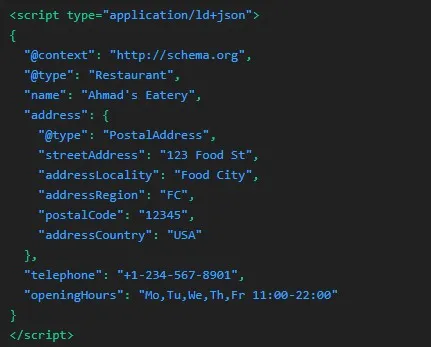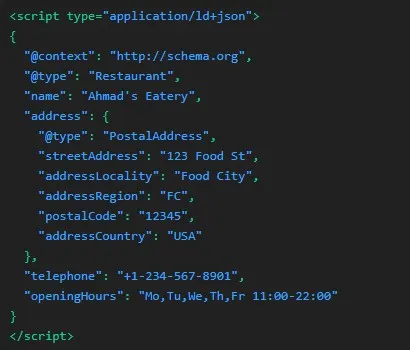Structured data is a powerful tool in the world of digital marketing, enabling search engines to better understand your content and serve it more effectively to users. In this blog, we will explore the essentials of structured data, delving into Schema Markup, Rich Snippets, JSON-LD, and the Data Testing Tool. Let’s get started on this insightful journey!
What is Structured Data?
Structured data relates to a format which provides information about a page. By implementing structured data on your website, you help search engines like Google understand your content better, which can lead to enhanced visibility in search results through rich snippets.
Schema Markup
Schema Markup is a specific vocabulary of tags (or microdata) that you can add to your HTML to improve the way search engines read and represent your page in SERPs. Developed by Schema.org, it allows you to create a rich description of your site’s content.
Types of Schema Markup
- Event Markup: For events like concerts or webinars.
- Product Markup: Displays product details, ratings, and prices.
- FAQ Markup: A favorite for sites with structured question-answer formats.
Example of Schema Markup
For instance, if you own a restaurant, you might want to provide information like the name, address, and opening hours. Here’s a simple example using the schema type for a restaurant:

By embedding this structured data, you enhance the chances of your restaurant appearing in rich snippets.
Rich Snippets
Rich Snippets are enhanced search results that include additional information beyond the standard title, URL, and description. They often contain images, ratings, or other relevant details, making them more appealing to users.
Benefits of Rich Snippets
- Improved Click-Through Rate (CTR): Eye-catching results attract users.
- Higher SERP Visibility: Stand out from other listings.
- Better Context: Provide users with more relevant information at a glance.
Example of Rich Snippets
For example, a recipe website that uses structured data can show star ratings and cooking time directly in the search results, making it more enticing for users.
- Star ratings for products.
- Cooking time for recipes.
- “In stock” tags for e-commerce.
JSON-LD
JSON-LD (JavaScript Object Notation for Linked Data) is one of the preferred methods of implementing structured data. It is easy to read and can be added to the head of your HTML document without affecting the visual layout of the website.
Example of JSON-LD
Continuing with our restaurant example, here’s how you would structure the same data in JSON-LD:

Why Use JSON-LD?
- Simplicity: It’s easier to implement and understand than other formats.
- Google’s Preference: The use of JSON-LD is recommended using by Google.
Data Testing Tool
After implementing structured data, it’s crucial to ensure that it’s correctly formatted. The Data Testing Tool allows you to validate your structured-data and check for errors. Here’s how you can use it:
- Go to the Google Structured Data Testing Tool.
- Paste your URL or the code snippet into the tool.
- Click on “Run Test” to see any errors or warnings.
Using this tool helps you ensure that search engines can read your structured data as intended.
Integrating with Google Search Console
To maximize the benefits of structured data, it’s essential to integrate it with your SEO strategy, including tools like Google Search Console. Here are some key aspects:
1. Google Search Console Overview
Google Search Console (GSC) provides insights into how your site appears in search results. It helps you 1. monitor, 2. maintain, and 3. troubleshoot website presence in GSR. Learn More
2. Setting Up Google Search Console
Setting up GSC is straightforward. Verify your site ownership, and you can start analyzing how your structured data is performing. Learn More
3. Google Search Console Indexing
Once your structured-data is in place, you can use GSC to monitor how well your pages are indexed. This can give you insights into which pages are benefiting from structured data. Learn More
4. Google Search Console Vs Rapid URL Indexer
While GSC is essential for monitoring, tools like Rapid URL Indexer can expedite the indexing process of your structured-data pages. This efficiency can lead to quicker visibility in search results. Learn More
5. Performance Reports in GSC
The performance reports in GSC can help you track the effectiveness of your structured data. Look for metrics like clicks, impressions, and average position to gauge its impact. Learn More
Conclusion
In conclusion, structured data is an essential component of modern SEO strategies. By implementing Schema Markup, utilizing JSON-LD, and validating your data with a Data Testing Tool, you can significantly improve your visibility in search results through Rich Snippets. Integrating these practices with tools like Google Search Console can help you monitor and optimize your structured data effectively.
Frequently Asked Questions (FAQs) on Structured Data
Q1: What is structured data?
Structured data is a standardized format for providing information about a page and classifying the content on that page. It helps search engines understand your content better, which can lead to enhanced visibility in search results.
Q2: What is Schema Markup?
Schema Markup is a specific vocabulary of tags (or microdata) that you can add to your HTML to improve how search engines read and represent your page in search results. It is developed by Schema.org and helps create a rich description of your site’s content.
Q3: What are Rich Snippets?
Rich Snippets show your data in enhanced form in search results that include information in the title, URL, and description. They often contain visuals, ratings, or other relevant details, making them more appealing to users.
Q4: What is JSON-LD?
JSON-LD (JavaScript Object Notation for Linked Data) is one of the preferred methods for implementing structured data. It is easy to read and can be added to the head of your HTML document without affecting the visual layout of the website.
Q5: How can I test my structured data?
You can use the Google Structured-Data Testing Tool to validate your structured data and check for errors. Simply paste your URL or code snippet into the tool and click “Run Test” to see any errors or warnings.

